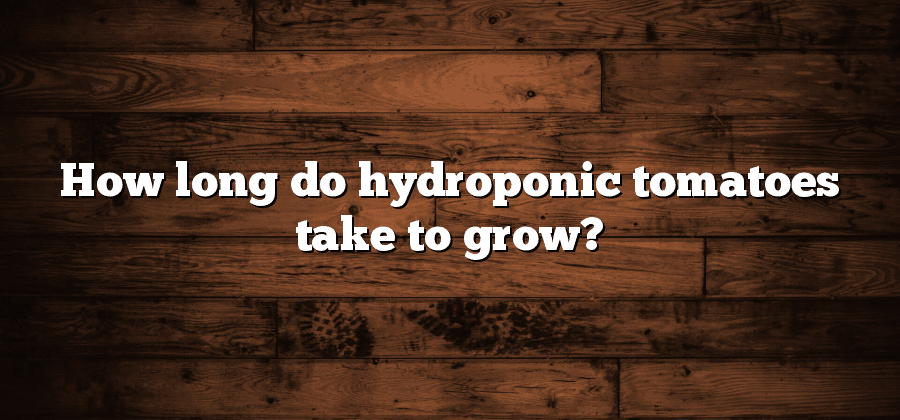Hydroponic Tomato Growth Timeframe
Hydroponic tomato growth timeframe is an essential consideration for growers seeking to optimize productivity and accurately plan their cultivation cycles. One of the key advantages of hydroponic systems is the ability to control and accelerate plant growth, resulting in faster maturation and higher yields compared to traditional soil-based cultivation methods. However, it is crucial to understand the typical timelines involved in each stage of hydroponic tomato growth to ensure optimal plant development and harvest.
In general, the hydroponic tomato growth timeframe can be divided into distinct phases, namely germination, seedling development, the vegetative growth stage, and finally, the flowering and fruiting stage. Germination usually occurs within 5 to 10 days after sowing the tomato seeds, depending on the cultivar and environmental conditions. Once the seeds have sprouted, they progress into the seedling development phase, which lasts around 2 to 3 weeks. During this period, the seedlings focus on developing a robust root system and acquiring sufficient nutrients to support further growth.
Factors Affecting Hydroponic Tomato Growth
Environmental factors play a crucial role in determining the growth and productivity of hydroponic tomato plants. One of the key elements that greatly affects tomato growth is light. Tomatoes require a specific amount and quality of light for optimal photosynthesis and growth. Insufficient light can result in weak and spindly plants with limited fruit production, while excessive light can lead to sunburnt leaves and stunted growth. It is essential to provide tomatoes with the right balance of light, typically around 12-16 hours per day, to ensure their healthy development.
Another significant factor that influences hydroponic tomato growth is temperature. Tomatoes are known to thrive in moderate temperatures, preferring a range between 70-80°F (21-27°C) for optimal growth. Temperatures higher than what they can tolerate can cause heat stress, leading to reduced flower and fruit production. On the other hand, temperatures below their ideal range can slow down their growth and impair nutrient absorption. Maintaining a suitable temperature in the hydroponic system is crucial to create an environment where tomato plants can flourish.
Understanding Hydroponic Tomato Germination
Hydroponic tomato germination is a critical stage in the growth process that sets the foundation for a successful crop. Germination refers to the process where a seed transforms into a seedling by sprouting and developing roots. In hydroponic systems, this process occurs in a controlled environment without the use of soil.
To understand hydroponic tomato germination, it is essential to recognize the key factors that contribute to its success. One crucial factor is the quality of the seeds used. High-quality seeds with a high germination rate are vital for obtaining healthy and vigorous seedlings. Additionally, the moisture and temperature levels must be carefully regulated to create optimal conditions for germination. Providing adequate moisture allows the seeds to absorb water and initiate the germination process, while maintaining an optimal temperature ensures that germination occurs within a reasonable timeframe.
As hydroponic systems become increasingly popular for growing tomatoes, an in-depth comprehension of the germination stage is crucial. By focusing on the factors that influence this process, growers can enhance their abilities to produce healthy seedlings and, ultimately, achieve successful and bountiful tomato crops.
Hydroponic Tomato Seedling Development
Hydroponic tomato seedling development is a crucial stage in the growth of hydroponic tomatoes. During this phase, the young tomato plants are transitioning from the germination stage to the vegetative growth stage. It is during this time that the seedlings establish a strong root system and develop their first set of true leaves.
To ensure successful seedling development in hydroponics, it is important to provide the ideal growing conditions. Optimal temperature, lighting, and nutrient levels are essential for healthy growth. The temperature should be maintained between 70-75°F (21-24°C) during the day and slightly cooler at night. Adequate lighting is crucial, and supplementing natural sunlight with artificial lighting is often necessary. Additionally, providing the right balance of nutrients, including nitrogen, phosphorus, and potassium, is essential for robust seedling development.
The seedlings should be closely monitored for any signs of nutrient deficiencies or pest infestations. Regular checks for pH levels and nutrient solution concentrations are important to ensure that the seedlings are receiving the right nutrition. Careful attention should also be paid to water quality and hygiene to prevent the spread of diseases. By providing the optimal growing conditions and monitoring the seedlings closely, hydroponic growers can support the healthy development of tomato seedlings, setting them up for successful vegetative growth in the next stage of their growth cycle.
Vegetative Growth Stage in Hydroponic Tomatoes
During the vegetative growth stage in hydroponic tomatoes, the primary goal is to establish a strong and healthy plant structure. This stage begins once the seedling has developed its first true leaves and continues until the plant starts flowering.
To achieve optimal vegetative growth, it is important to provide the plants with the ideal conditions. This includes maintaining suitable temperature and humidity levels, providing adequate lighting, and ensuring proper nutrition. In hydroponic systems, nutrient solutions are carefully formulated to provide all the necessary elements for plant growth. Monitoring and adjusting the nutrient solution’s pH level is crucial to ensure that the plants can absorb the nutrients effectively. Additionally, providing sufficient oxygen to the plant’s root system is essential for healthy growth. This can be achieved by using well-aerated growing media or using techniques such as oxygenation through air stones.






